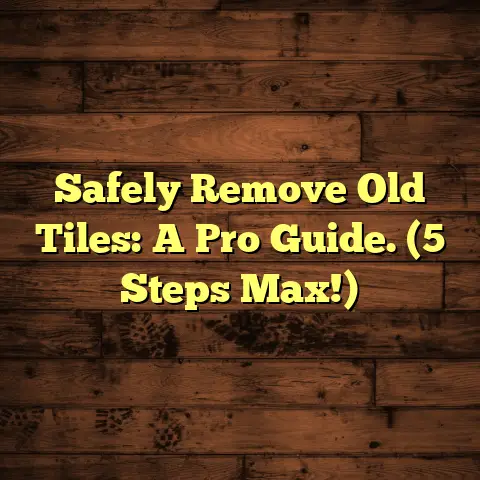Keep Kitchen Floors Dry: How To (6 Must-Do Steps!)
Let’s talk kitchens.
The heart of the home, right?
Where we whip up culinary masterpieces, share family meals, and, let’s be honest, sometimes create a bit of a mess.
Through the ages, kitchens have been the central gathering place.
But with all the modern gadgets and cooking adventures, keeping those kitchen floors dry has become super important.
Why? Because nobody wants a slip-n-slide situation in their own kitchen!
Plus, wet floors can lead to bigger problems down the road.
That’s why I’m here to spill the beans (pun intended!) on how to keep your kitchen floors dry as a bone.
I’ve been a flooring contractor for over 15 years, and I’ve seen it all – from minor spills to major water damage.
Trust me, a little prevention goes a long way.
In this article, I’m going to walk you through six must-do steps that will keep your kitchen floors safe, clean, and looking their best.
Ready to dive in?
Section 1: Understanding the Importance of a Dry Kitchen Floor
Okay, let’s get real for a second.
Why is a dry kitchen floor such a big deal?
Well, for starters, wet floors are a major slip hazard.
According to the National Floor Safety Institute, slips and falls are a leading cause of injury in the home, and kitchens are a prime location.
Think about it: you’re rushing around, grabbing ingredients, maybe a little water splashes here and there…
Before you know it, you’re doing an unintentional ice-skating routine.
Not fun!
But the risks don’t stop there.
Moisture can also lead to mold growth, which is definitely not something you want in your kitchen.
Mold loves damp, dark places, and a wet floor provides the perfect breeding ground.
And let’s not forget about the damage moisture can do to your flooring itself.
Hardwood, for example, can warp and swell when exposed to water.
Laminate can bubble and peel.
Even tile, while more water-resistant, can suffer from grout damage.
Here’s a quick breakdown of how moisture can affect different flooring types:
| Flooring Type | Potential Damage from Moisture |
|---|---|
| Hardwood | Warping, swelling, staining |
| Laminate | Bubbling, peeling, joint damage |
| Tile | Grout damage, cracking |
| Vinyl | Adhesive failure, discoloration |
Beyond the safety and structural concerns, a dry kitchen floor is just plain cleaner.
Think about all the food particles and crumbs that end up on the floor.
When those mix with water, you’ve got a recipe for bacteria and unpleasant odors.
A dry floor is easier to sweep, mop, and keep generally hygienic.
I always tell my clients that maintaining a dry kitchen floor is an investment in their home’s longevity and their family’s well-being.
It’s about preventing accidents, protecting your flooring, and keeping your kitchen a healthy and enjoyable space.
Section 2: Step 1 – Regular Cleaning Habits
Alright, let’s get down to the nitty-gritty.
The first step to a dry kitchen floor is establishing regular cleaning habits.
I know, I know, cleaning isn’t the most exciting activity, but trust me, it’s worth it.
Think of it as preventative maintenance for your floors.
So, what does a good cleaning routine look like?
Well, it depends on your flooring type and how much traffic your kitchen gets.
But here’s a general checklist to get you started:
- Daily: Sweep or vacuum to remove loose dirt and crumbs. This is especially important under the table and around the cooktop.
- Weekly: Mop the floor with a suitable cleaner. Be sure to wring out the mop thoroughly to avoid leaving excess water behind.
- Monthly: Give your floors a deep clean. This might involve using a specialized cleaner or steam mop, depending on your flooring type.
Now, let’s talk about cleaning products.
Not all cleaners are created equal.
You need to choose products that are specifically designed for your flooring type.
Using the wrong cleaner can damage the finish or even discolor your floors.
For example, hardwood floors should be cleaned with a pH-neutral cleaner that’s formulated for wood.
Avoid using harsh chemicals or abrasive cleaners, as these can scratch the surface.
Laminate floors can be cleaned with a damp mop and a mild detergent.
Again, avoid using excessive water, as this can seep into the seams and cause damage.
Tile floors are generally more durable and can be cleaned with a variety of cleaners.
However, you should avoid using abrasive cleaners on glazed tile, as these can dull the finish.
When it comes to cleaning tools, I’m a big fan of microfiber mops.
They’re super absorbent and do a great job of picking up dirt and grime.
Plus, they’re easy to clean and reuse.
Of course, accidents happen.
Spills are inevitable in the kitchen.
The key is to address them quickly.
Keep a roll of paper towels handy for wiping up spills as soon as they occur.
For sticky spills, you may need to use a damp cloth and a mild cleaner.
Remember, the longer a spill sits, the more likely it is to soak into the flooring and cause damage.
By establishing regular cleaning habits, you can prevent moisture from accumulating on your kitchen floors and keep them looking their best for years to come.
Section 3: Step 2 – Use Mats and Rugs Strategically
Okay, so you’re sweeping and mopping like a pro.
That’s great!
But there’s another simple yet effective way to keep your kitchen floors dry: using mats and rugs strategically.
Think of mats and rugs as your first line of defense against spills and moisture.
They act as barriers, absorbing water and preventing it from spreading across the floor.
But not all mats are created equal.
You need to choose the right types of mats and place them in strategic locations to maximize their effectiveness.
Here are a few recommendations:
- Under the sink: This is a prime spot for leaks and drips. Place an absorbent kitchen mat under the sink to catch any water that might escape.
- In front of the dishwasher: Dishwashers can sometimes leak or overflow. A rubber mat with a raised edge can help contain any spills.
- Near the stove: Cooking can be a messy business. Place a mat near the stove to catch splatters and spills.
- Entryways: Place a mat at each entryway to your kitchen to trap dirt and moisture from shoes.
When choosing mats, look for materials that are absorbent, durable, and easy to clean.
Microfiber mats are a great option for absorbing spills.
Rubber mats are good for preventing slips and protecting the floor from scratches.
And don’t forget about style!
Mats and rugs can also add a touch of personality to your kitchen.
Choose colors and patterns that complement your décor.
Of course, mats and rugs need to be cleaned regularly to maintain their effectiveness.
Vacuum them frequently to remove dirt and crumbs.
Wash them according to the manufacturer’s instructions.
And be sure to replace them when they start to wear out or lose their absorbency.
I’ve seen so many kitchens saved from water damage simply by using mats and rugs strategically.
It’s a small investment that can make a big difference in the long run.
Section 4: Step 3 – Invest in Proper Ventilation
Now, let’s talk about something that’s often overlooked: ventilation.
Proper ventilation is crucial for keeping kitchen floors dry, especially in areas prone to humidity and moisture.
Think about it: when you’re cooking, you’re releasing steam and moisture into the air.
If that moisture isn’t properly vented, it can condense on surfaces, including your floors.
And as we’ve already discussed, moisture can lead to all sorts of problems.
So, what are your ventilation options?
Here are a few of the most common:
- Exhaust fans: Exhaust fans are designed to remove steam and odors from the kitchen. They’re typically installed above the stove or cooktop.
- Windows: Opening a window can help to ventilate the kitchen, especially when you’re cooking or cleaning.
- Dehumidifiers: Dehumidifiers remove moisture from the air. They can be particularly helpful in kitchens that are prone to humidity.
The best ventilation option for your kitchen will depend on your specific needs and circumstances.
If you cook frequently, an exhaust fan is a must.
If you live in a humid climate, a dehumidifier can be a lifesaver.
And if you have windows in your kitchen, be sure to open them regularly to let in fresh air.
I often advise clients to assess their kitchen’s ventilation needs by observing how much moisture accumulates on surfaces when they’re cooking.
If you notice condensation on your windows, walls, or floors, it’s a sign that you need to improve your ventilation.
Installing an exhaust fan is a relatively simple project that can be done by a DIYer.
However, if you’re not comfortable working with electricity, it’s best to hire a professional.
Dehumidifiers are easy to set up and operate.
Simply plug them in and set the desired humidity level.
By investing in proper ventilation, you can prevent moisture from accumulating on your kitchen floors and create a healthier, more comfortable environment.
Section 5: Step 4 – Fix Leaks Promptly
Okay, this one might seem obvious, but it’s so important that it bears repeating: fix leaks promptly!
Leaks from plumbing, appliances, or walls are a major source of water damage in the kitchen.
Even a small leak can cause significant damage over time.
So, how do you identify leaks in your kitchen?
Here are a few common sources to check:
- Under the sink: Check the pipes and connections under the sink for drips or signs of moisture.
- Around the dishwasher: Inspect the hoses and connections around the dishwasher for leaks.
- Behind the refrigerator: Check the water line that supplies the ice maker and water dispenser for leaks.
- Around the faucet: Look for drips or puddles around the base of the faucet.
- Walls and ceilings: Check for water stains or discoloration on walls and ceilings, which could indicate a leak from above.
If you find a leak, don’t ignore it!
Address it immediately to prevent further damage.
For minor leaks, you may be able to handle the repairs yourself.
For example, you might be able to tighten a loose connection or replace a worn-out washer.
However, for more complex leaks, it’s best to call a professional plumber.
Trying to fix a major leak yourself could end up causing more damage and costing you more money in the long run.
I’ve seen countless kitchens where a small, easily fixable leak was ignored for too long, resulting in extensive water damage and costly repairs.
Don’t let that happen to you!
Be vigilant about checking for leaks, and address them promptly.
Your kitchen floors (and your wallet) will thank you.
Section 6: Step 5 – Choose Water-Resistant Flooring
Alright, let’s talk flooring.
If you’re planning a kitchen renovation or simply replacing your existing floors, consider choosing water-resistant or waterproof materials.
This is especially important in kitchens, where spills and moisture are common.
There are several excellent water-resistant flooring options available, including:
- Vinyl: Vinyl flooring is highly water-resistant and comes in a wide variety of styles and colors. It’s also relatively affordable and easy to install.
- Tile: Tile is another excellent water-resistant option. It’s durable, easy to clean, and comes in a huge range of styles and patterns.
- Treated hardwood: Hardwood floors can be treated with a water-resistant finish to protect them from moisture. However, it’s important to note that even treated hardwood is not completely waterproof.
Here’s a quick comparison of these flooring options:
| Flooring Type | Water Resistance | Maintenance | Cost |
|---|---|---|---|
| Vinyl | High | Easy | Moderate |
| Tile | High | Easy | Moderate |
| Treated Hardwood | Moderate | Moderate | High |
When choosing flooring, consider your budget, your lifestyle, and your aesthetic preferences.
If you have young children or pets, you might want to opt for a more durable and water-resistant option like vinyl or tile.
If you love the look of hardwood, you can choose a treated option, but be prepared to take extra care to protect it from moisture.
No matter what type of flooring you choose, it’s important to maintain it properly.
Clean spills promptly, and avoid using excessive water when mopping.
By choosing water-resistant flooring and caring for it properly, you can protect your kitchen floors from water damage and keep them looking beautiful for years to come.
Section 7: Step 6 – Establish a Family Policy
Okay, we’ve covered a lot of ground so far.
But here’s the thing: keeping your kitchen floors dry isn’t just a one-person job.
It requires a collective effort from the entire family.
That’s why it’s so important to establish a family policy regarding kitchen cleanliness and safety.
Think of it as a set of guidelines that everyone agrees to follow to keep the kitchen a safe and enjoyable space.
Here are a few ideas to get you started:
- Designated clean-up times: Set aside a few minutes each day for everyone to help clean up the kitchen. This could involve wiping down counters, sweeping the floor, or doing the dishes.
- Spill patrol: Make it a rule that everyone is responsible for wiping up spills immediately. Keep paper towels or cloths readily available for quick clean-ups.
- Shoe policy: Consider implementing a no-shoes policy in the kitchen to reduce the amount of dirt and moisture tracked onto the floors.
- Education: Teach your family members about the risks of wet floors and the benefits of keeping surfaces dry. Explain why it’s important to clean up spills and be mindful of water usage.
Involving your family in maintaining a dry kitchen not only makes the task easier but also fosters a sense of responsibility and teamwork.
When everyone is on board, it’s much more likely that your kitchen floors will stay dry and safe.
Conclusion
So, there you have it – six must-do steps to keep your kitchen floors dry.
From establishing regular cleaning habits to choosing water-resistant flooring, these tips will help you create a safer, cleaner, and more enjoyable kitchen environment.
Remember, maintaining dry kitchen floors isn’t just about aesthetics.
It’s about preventing accidents, protecting your flooring, and promoting overall hygiene.
By implementing these practices, you’re investing in your home’s longevity and your family’s well-being.
And let’s be honest, there’s nothing quite like the satisfaction of a well-maintained kitchen space.
So, go ahead, put these tips into action and enjoy the peace of mind that comes with knowing your kitchen floors are dry, safe, and beautiful.
Happy cleaning!





